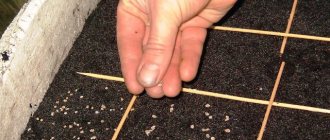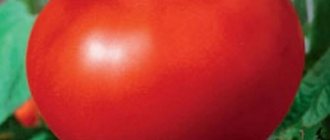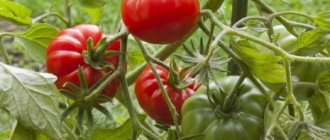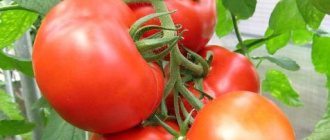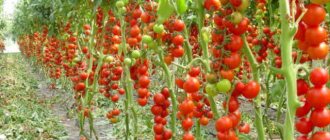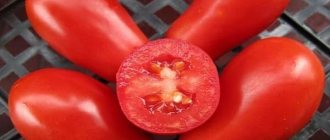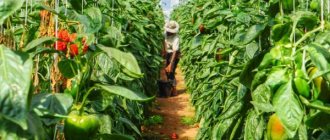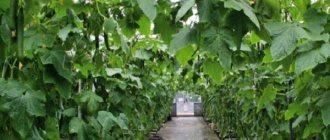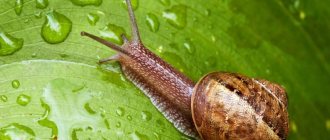Anyone who doesn’t know how to grow tomatoes in a greenhouse should learn from experienced gardeners and study information on this topic.
Then there will be fewer problems with plants, and the harvest will grow many times better. Lack of control over the growth of green mass directly affects the ripening of fruits. If the bush is dense, then the fruits of the required size will not grow and fewer will be formed. The main reason for this is the improper formation of tomatoes in the greenhouse. Favorable conditions of the greenhouse environment contribute to the formation of a large number of lateral shoots in the leaf axils. To prevent this phenomenon and ensure that all parts of the plant receive nutrients in optimal quantities, it is necessary to find time to control the growth of an adult tomato. It will be enough to pay attention to the timely removal of stepsons in order to form a bush with 1-2 trunks .
In order not to worry about the formation of bushes, some people solve this problem; you can opt for determinate varieties that do not require constant removal of stepsons. However, the harvest obtained from such bushes is worse. The low productivity of determinate varieties does not justify their cultivation in greenhouses.
Formation of tomato bushes in a greenhouse (video)
The technology for forming a bush when growing cherry tomatoes does not differ from the classical one:
- when removing excess stepsons, the stumps are preserved;
- the foliage under the fruiting clusters is trimmed;
- at the same time the bushes are tied up.
The scheme is the same as for simple tomatoes:
- for determinate varieties, 1-3 stems are left, depending on the desired amount of harvest;
- Indeterminate cherries sometimes retain four shoots.
The formation of a tomato bush in a greenhouse is influenced by the variety: indeterminate, semi-determinate, determinate, standard. Hence the order and necessity of removing side shoots in the axillary part of the leaves.
- Indeterminate plants constantly grow and produce flowers and fruits. The plant forms 1 stem by removing the stepsons.
- Semi-determinate tomatoes are characterized by continuous growth of stems. There should be two of them, subject to proper agricultural technology.
- Determinate varieties with limited growth even in the greenhouse. The bushes are pruned, leaving 2-3 stems and 6-7 flower clusters.
- Standard tomatoes resemble a small tree. They grow to a certain height and do not require the formation of a bush. Tomatoes are easy to grow, but produce fewer fruits compared to indeterminate varieties.
Seedlings planted in a greenhouse must adapt for some time to the new conditions of closed ground. Leave for 2-2.5 weeks and then inspect the plants for pinching. Shoots to be removed must reach a length of over 5 centimeters. Usually by that time the first cluster of flowers appears. High varieties of tomatoes form a stepson above 9-10 leaves.
It is important not to overdo it with removing shoots and not to carry out pinching more than once a week. Otherwise, injury will weaken the vitality of the plant and negatively affect fruiting.
- It is best to carry out the procedure early in the morning in dry, sunny weather. Within a day, the damaged areas dry out and become covered with a film.
- The stepsons break out without leaving stumps, so as not to provoke the growth of new shoots.
- To form a bush, use a clean knife or carefully break off a branch with your hands. After the procedure, the instrument is treated with potassium permanganate.
- They try to form one stem per plant. The optimal option gives the highest yield, since there is the best supply of water and nutrients to all parts of the plant.
- The first side shoots are cut off. Leave one fruiting cluster on the stem. Preserving 2-3 leaves in front of flowers and fruits helps to better provide the plant with nutrition.
- It is not recommended to immediately expose the trunk at one time. Remove no more than three leaves.
- When caring, be sure to tie the stem and branches to a support. Due to their constant growth and large number of fruit-bearing branches, indeterminate varieties find it difficult to bear weight.
We suggest considering how to form tomatoes in a greenhouse.
After transplanting the tomatoes into the greenhouse, after about 2 weeks, it is necessary to carry out the first shaping. In this case, you need to determine the main stem where the flower cluster grows. Further, this process is recommended to be done every 10 - 12 days. This event should be carried out in the morning or evening, at which time it is easy to tear them off. In order for stepsoning to be effective, you need to break off the shoots not completely, but leave 2 or 3 cm, which will prevent a new stepson from growing.
The formation of tomatoes in a greenhouse can be one, two or three stems. To form one, you just need to remove all the shoots. If you need two stems, then leave the shoot that is located closer to the first flower cluster. And the third one is also formed, but only under the second stem.
For maximum yield, it is recommended to leave 4 brushes on each stem. Everything else must be deleted. Shoots that begin to grow in the root zone should also be removed. After the first stepsoning procedure, it is necessary to tie it to pegs that are inserted next to the bush. If this is not done, the bush will bend due to the tomatoes, which will lead to its breakage.
In a polycarbonate greenhouse, it is necessary to choose the right time for carrying out the planned manipulations. You can minimize possible seedling stress using several tricks. Firstly, gartering and pinching is carried out early in the morning. Secondly, even partial removal of secondary shoots is carried out no more than once every 8-9 days, otherwise the plant will quickly wither.
Before you start forming a tomato bush in a greenhouse, you should watch a training video
In addition, the correct formation of the bush is carried out taking into account the recommendations given below by botanists:
- No more than 3 leaves are removed at a time;
- All manipulations are carried out in a polycarbonate greenhouse in moderately warm and dry weather;
- It is possible to carry out molding in a humid climate, but first you will need to treat the existing weak sections with a solution of potassium permanganate;
- It is allowed to remove only those stepsons whose length is at least 55 cm;
- It is forbidden to leave even small stumps;
We suggest you familiarize yourself with: Lamps for greenhouses: which ones to choose for greenhouse lighting, infrared, sodium and LED lamps
The formation of a tomato bush in a greenhouse depends on the variety. Different varieties require a unique scheme for removing stepchildren:
- Indeterminate - characterized by constant development of the main trunk and regular fruiting. Such varieties are formed into 1 stem with the removal of additional shoots, which help reduce the number of fruits.
- Semi-determinant - constant development of the stem with cessation of growth under unfavorable conditions. Formation is carried out in 2 stems.
- Determinant - development up to a certain point. Such tomatoes are formed into 2-3 stems, leaving about 7 flower clusters on the plant due to the insufficiently strong vegetation.
- Standard - determinate varieties with a shortened, strong stem and foliage similar to the crown of a tree. Does not require any shaping, pinching, or gartering.
The formation of undersized tomatoes that grow up to a certain time is carried out taking into account the following features:
- Early ripening varieties do not require the removal of side branches, since the fruits on them ripen before the bush grows. These tomatoes are very easy to care for due to their small size.
- It is better to leave tall bushes with one stem; for this purpose, additional stems are removed approximately once a week to ensure an increase in fruits.
- On medium bushes you can leave 3 stems, removing the central shoot to ensure branching of the bush; pinching is carried out according to the general scheme.
In determinate bushes, after the appearance and development of stepsons up to 5-7 cm, usually 3 stems are formed (you can leave one or two). To do this, stepsons are left in the axil of the first two leaves (the lowest ones). They grow on the mother bush as independent plants - they form leaves and fruits. The remaining vegetative stepsons on the central and two auxiliary shoots are constantly broken out when they reach 5-7-10 cm.
Remember! Determinate bushes complete their growth by forming a flower cluster at the end of the stem. Such a stem will no longer grow and form fruiting clusters. In order to prolong the fruiting of the bush, each time when cutting, it is necessary to identify a stepson that will replace the old stem that has finished growing and leave it for further growth, and remove the rest.
If the central stem continues to develop and form fruits, then the grown stepson is pinched 3-4 cm and this technique limits its growth, but does not remove it.
Indeterminate tomato bushes, due to their biological characteristics, have unlimited growth up to 2.0 meters or more. They are almost always formed into one stem to produce large fruits. To do this, after planting seedlings or the final thinning of seedless varieties and hybrids of tomatoes with the appearance of stepchildren, the formation of bushes begins. In the axils of the leaves, all the stepsons are broken out. The crop is formed only on the central stem.
Common diseases
Late blight is the most common disease of nightshade crops (potatoes, tomatoes, peppers, eggplants). Affects leaves, stems, fruits. In years favorable for the development of the disease, the harvest can be lost in 3–4 days.
Gray mold is most common in greenhouses. Dark wet spots with a gray fluffy coating appear on the leaves and fruits. The disease develops more severely at temperatures of 15 °C and above and with excessive moisture. Damaged fruits lose their marketable appearance and are not preserved.
During the ripening period of tomatoes, the fungicide Quadris is used to protect against late blight, Alternaria blight, cladosporiosis, and gray rot. This drug has a complex effect against many diseases and has a very short waiting period, only 5 days, it is used both in open ground and in greenhouses during the phase of budding and ripening of fruits. The drug has a short waiting period and significantly improves the shelf life and presentation of products.
They are used fresh, varieties and hybrids are very good for canning, tomatoes look very nice in a jar. Due to its high sugar content, it is perfect for making ketchups and sauces.
At this point, countless numbers of tomatoes have been created. Each variety differs from each other in size, color, taste and structure of the bush. Planting indeterminate tomatoes is the main condition for a good harvest.
Due to the difference in plant shape and height, tomatoes are divided into indeterminate and determinate; an experienced person can determine which type a tomato belongs to. These varieties have a simpler name, by which you will understand the difference between these subspecies. Determinate plants are also called stunted plants, and indeterminate plants are called tall plants. Planting indeterminate tomatoes allows you to increase the yield.
If you plan to grow tomatoes in a greenhouse, then you need to properly use the soil surface; planting indeterminate tomatoes is an important procedure. Because tomatoes are unlikely to be the only inhabitants of your greenhouse. Most likely, you will grow something other than tomatoes there. And this something will also need a considerable part of the land. The formation of indeterminate tomatoes is the most important condition for a good harvest.
Preparing for stepsoning
Abundant nutrition of tomato plants causes increased branching of side shoots. Greens thicken the planting of tomatoes, which contributes to the appearance of fungal and other diseases. A large number of small fruits are formed. To prevent this from happening, gardeners use a technique called bush formation or pinching.
The technique helps to balance the ratio of the green mass of plants with the amount of the emerging crop. Sometimes, to obtain large fruits, individual flowers or the entire flower cluster are removed.
Stepchildren are located in the axil of the leaf located on the main stem. In nature, the plant thus fights for survival; when grown in culture, the plant does not always need stepsons and must be removed.
Pruning begins during the planting period and continues throughout almost the entire growing season. When plants become diseased, the shoots are left in the axils of healthy leaves in order to still get a fruit harvest.
In most tall, especially large-fruited tomatoes, the first fruit cluster appears above the 8-9th leaf, and in some above the 11th leaf. Usually, by the time the first peduncle is formed, conditions are created for the creation of 1 or 2 additional stems from emerging stepsons or lateral shoots.
Formation of an additional stem above the first fruit cluster on the 'Family F1' tomato
You can also form an additional shoot above the first inflorescence. But neither on the main nor on the additional stems should the growth of stepsons be allowed: 5 cm and “head off shoulders”. Missed stepsons that have grown again in the same leaf axils have no right to interfere with the organic development of plants.
Stepchildren cannot be allowed to grow back
Stepsoning (removal of stepsons) can be carried out at any time of the day, provided the whole plant has good turgor. More often, or better before working with each plant, treat scissors or pruning shears with an antiseptic: alcohol, vodka, moonshine or cologne.
Sterilize scissors or pruning shears with an antiseptic often
Tall tomatoes planted in beds under arches with large fruits (more than 150 g) will not boast of abundant fruiting, but cherry tomatoes formed into 2-3 stems will amaze with their productivity. Conclusion - the tops of tall tomatoes should not be allowed to rest against the covering material of a greenhouse or greenhouse.
An important condition for the effective cultivation of tall tomatoes is the rationing of the bunches, that is, the removal of excess fruits that are obviously doomed to underdevelopment. This technique helps the plants stay in good shape and their fruits to be uniform in size and beautiful. In addition, due to this simple operation, the number of ovaries increases by 20%, and the increase in yield reaches 30%.
We suggest you read: How to build a winter greenhouse with heating with your own hands
Pinching tomatoes means breaking off unnecessary shoots, and topping involves pinching the top of the bush.
These actions will stop the growth of the bush, providing you with a good harvest. They are also important for the following reasons:
- Without proper control, a tomato bush can grow greatly, as new stepsons are formed all the time. If this is allowed, then the plant will spend a lot of energy on the further appearance of stepsons, and not on growing tomatoes. It is also worth noting that determinate varieties require little pinching, which cannot be said about indeterminate types of tomatoes.
- Stormy foliage on the bushes reduces the ventilation process, increasing the humidity in the greenhouse. What is the main cause of diseases and parasites.
Thus, pinching and topping ensures that you get the maximum yield and prevents any plant diseases from appearing. And comfortable watering and caring for the bushes is a pleasant addition to the above actions.
The following rules for this process are distinguished:
- It is recommended to break off the stepsons no more than once every 8–10 days;
- the best time of day is morning or evening;
- Formation is best done in warm and dry weather. And if humidity is present, then pour the sections with a solution of potassium permanganate to protect against microbes;
- It is best to break off stepsons that are 5–6 cm in size;
- you should leave 2 - 3 cm from the broken stepson so that a new one does not grow in its place;
- if you do not break off the stepsons, but cut them out, then the tool must be treated with a solution of potassium permanganate.
You can form tomatoes in a greenhouse using the pinching method. In order for the plant to return to normal faster after this procedure, it is necessary to properly tear off the leaves and shoots:
- The procedure for removing unnecessary plant elements should be carried out no more than once a week.
- It is recommended to carry out pinching early in the morning so that the damaged areas have time to be covered with a film and dry out. Picking off shoots and gartering tomatoes can be done in different ways, the video below explains this.
- To form a bush, it is better to choose a dry sunny day.
- To protect against the entry of pathogenic microorganisms, the fracture site should be washed with a solution of potassium permanganate.
- Only stepsons 5-6 cm long are cut off so as not to remove the apical buds by mistake.
- It is better to remove side shoots completely, without leaving stumps that can become moldy or provoke the re-development of the stepson.
- Stepchildren can be removed in different ways: broken off or cut off. After cutting, the tool should be disinfected with a weak solution of potassium permanganate.
The purpose of this action is one - to create optimal conditions for increasing the mass of fruits and their rapid ripening. If you do not take this rule into account, then you may not expect a good harvest. Any vegetable crop requires at least minimal care so that the result at the end of the season is not disappointing.
It is difficult for summer residents without experience to distinguish between stepsons and leaves. Before forming a bush, it is important to look at the tomato plant and understand that the shoot grows from a bud between the stem and the base of the leaf.
Simultaneously with the removal of the shoot, the tomatoes are tied up. To carry out the work, prepare the following equipment and tools:
- for pinching, a solution of potassium permanganate, water, scissors or a knife is required;
- for tying you need supports and rope.
Do no harm: basic rules
Pinching is an agrotechnical technique for removing a shoot in the axil of a leaf and one of the elements of bush formation.
Favorable conditions for work are dry weather, moderate temperature, absence of dew on the plant.
About a day before work, stop watering and fertilizing so that the plants have time to dry.
Carefully! When pinching and pruning wet plants, there is a risk of harmful fungi and viruses getting into fresh wounds.
Damaged areas are especially often affected by gray rot, a fungus that progresses in conditions of high humidity and high temperature.
There are certain rules, the implementation of which will ensure a positive result:
- The knife and hands are disinfected with a 1% solution of potassium permanganate.
- Stepchildren are removed when they have reached 4-5 cm. Break them out manually, bending them to the side with force.
- When removing overgrown stepsons, the plant is more injured. It is better to carefully cut them with a knife so as not to damage the stem when breaking them out.
- A piece of shoot is left in the axil of the leaf - a small stump, which will prevent the formation of a new stepson in this place. This reduces the risk of stem damage.
- Pinching the tops is carried out over the last flower brush, which is used to finish the growth of the plant. It is important to leave a couple of leaves above the brush to improve photosynthesis.
- Leaves are trimmed below the blooming flower clusters. You need to remove no more than 2-3 healthy leaves per week.
Advice! Vegetative organs with signs of disease are removed immediately.
Recommendations for beginners: how to form a tomato bush in a greenhouse
The gardener’s task is to provide the fruits with the necessary amount of moisture and nutrients. For these purposes, cultivation is carried out according to a 1-stem scheme. If there are a significant number of secondary shoots on the main stem, this will lead to the death of the plant.
The method of forming a tomato bush should be chosen depending on the variety.
In the event that no external “shocks” move forward, the side shoots are removed 2-3 weeks after planting.
The further procedure is as follows:
- Avoiding drying of seedlings will help to remove, without exception, the lower leaves located under the cluster with green fruits;
- It is allowed to leave 1-2 leaves after the brush if the main stem has not yet acquired the necessary resistance;
- If the weather outside the window cannot boast of moderation, you need to leave 1-2 branches on the first few stepsons.
Taking into account climatic features is the key to active growth and development of indeterminate varieties. The scheme provides for complete or partial removal of lateral shoots, depending on climatic conditions. Unlike determinate varieties, which can withstand any number of secondary shoots, indeterminate counterparts require the removal of a small number of shoots in order to accelerate growth.
This variety requires only one stem, which will provide the necessary nutrition and moisture. Let's look at the recommendations for this variety:
- For ideal growth it requires breaking off all the stepsons.
- It is necessary to remove all the lower leaves under the cluster of unripe tomatoes, which will increase the yield of the bush. Be careful: you should tear off no more than 3 leaves at a time.
- Drive in the stakes and tie the plant to them. Often one stem cannot hold a large number of fruits and breaks.
We invite you to read: Description of the Pygmy tomato: advantages and disadvantages of the variety
The formation of constantly growing plants must be done with your own hands. The best option would be to create single-stem bushes. It is this configuration option that contributes to optimal nutrition of all fruits and providing them with a sufficient amount of water.
Rules for the formation of indeterminate bushes:
- Single-stem formation most often involves the removal of all stepsons, leaving only the main stem.
- Another method involves partial removal of the first stepsons, leaving one fruitful branch at a time. It is important to leave a couple of leaves after the brush to prevent disruption of liquid circulation.
- It is necessary to pluck off the lower foliage under the clusters in order to control growth and better productivity of the bush. It is advisable to remove no more than 3 leaves in one procedure, so as not to harm the plant.
- Attention should be paid to the garter, since the stem of indeterminate tomatoes is not able to support the weight of fruits and foliage developing over time. You can study in detail how to properly form a bush in the video posted on this page.
Tomato yield reserves - how to change them in your favor
Adding an article to a new collection
To increase the number of tomatoes you get from your plantation, you don’t need to grow super-large bushes or feed them with fertilizers. It is enough to choose the variety correctly and form the plant correctly.
To the question: “What tomatoes should be grown in a greenhouse?” 9 out of 10 gardeners will answer: “Of course, indeterminate (tall).” On the one hand, this is correct. But only with one. What should those who have a short summer do and only have time to ripen 4-5 tomato bunches? Only 2-3 kg per bush is very little. There is enough to eat, but you still need to make some seaming and leave the green fruits for the fall to extend the season of fresh tomatoes.
Can I just plant more bushes? What if there is nowhere to go?
There is a way out: we plant determinate tomatoes in a greenhouse and form them into tall ones. Let's look at the features of each type.
Learning the Basics: Forming Tomatoes in a Greenhouse
First you need to understand that the basis of correct actions is taking into account the form of the course. This indicator differs depending on the selected tomato variety. The list opens with indeterminate varieties, characterized by rapid growth of the main stem.
You can remove excess stepsons either with your hands or with scissors.
In most cases, the bush is always formed into one stem. In this case, all side shoots must be removed.
In addition to these indeterminate varieties, a number of others stand out:
- Semi-determinant - the growth process is permanent, however, under certain conditions, it can stop. Among the possible causes, botanists identify a sharp cold snap, a lack of nutrients and irregular watering.
- Determinate - their growth is strictly limited. One of the possible boundaries is the level of height established at the level of heredity or the laying of 6 flower tassels.
- Superdeterminant - there is no need for pinching. In this case, the gardener is responsible for removing unnecessary shoots. As practice shows, it is necessary to form a stem
- Standard - the stem always grows to a medium level, while having a tree-shaped crown. This variety does not require tying or pinching. Thanks to this, caring for them takes much less time.
The correct formation of a tomato bite largely depends on its variety. The growth rate, the number of additional shoots, the need to remove them - you need to know all this before you start gardening. The information is almost always indicated on the seed package, so you need to read it carefully.
In what cases should growth be slowed down?
The rapid development of plants can be caused by various factors that influence the choice of method for slowing the growth of tomato seedlings. The reasons can be called:
- Excess nitrogen fertilizers. These compounds lead to intensive growth of green mass at an accelerated pace.
- Incorrect sowing time. When choosing the time for planting seeds, you should focus on the age of seedlings recommended by the manufacturer for placement in the ground, as well as the climate of the area. The length of stay indoors has a negative impact on the condition of the plants, so early sowing will not benefit the crop.
- Overwatering. Excessive watering often leads to stretching of the stems.
- Temperature violation. Proximity of heat sources causes wilting or excessive elevation gain.
- Poor lighting. Short day lengths during the spring months mean that the stems of tomato seedlings may stretch out in search of additional light. At the same time, daylight hours longer than 14 hours accelerate the development of plants more than usual.
Specifics of the formation of indeterminate tomatoes
If the information indicated on the packaging allows us to conclude that the tomato variety belongs specifically to this category, then the further procedure is as follows.
From a practical point of view, the design of a mature plant allows for only one stem. Stepping, carried out once every 10 days, will help improve the dynamics of development. The main thing is to remove side shoots moderately, otherwise, instead of increasing the yield, it will be significantly reduced.
In addition, the gardener can take on board the following recommendations:
- The minimum distance between beds is 30 cm;
- The maximum permissible number of stems is from two to three;
- The point is removed 3-4 months after planting.
The development and formation of bits in determinate bits occurs while maintaining a minimum distance, both between shoots and between beds. In second place in importance is the requirement to use manual processing. In this case, low-growing bushes will not be damaged.
There is a special diagram showing how determinate tomato varieties can be formed
Now let's look at how to form determinate varieties of tomatoes:
- They are usually small in size, which makes them easy to care for. And also, for most of them, the shoots do not have to be broken off at all.
- For taller bushes, you can leave 1 stem, which needs to be pruned once every 10 days, which may well double the yield.
- For low species, 2 or 3 stems should be formed.
Features of determinate varieties of tomatoes
These tomatoes are designed for early and friendly harvest. But they have a peculiarity - the plant matures after the formation of the third to fifth cluster. Each branch produces many stepsons, which also bear 3-5 tassels and also become crowned (finish their growth).
Formation of a determinate variety of tomato
Thus, due to the formation of more and more stepsons, the determinate tomato bush grows in width. The shoots grow all the time, and flower clusters and fruits form on them. The process must continue continuously until the cold weather, and if you don’t have this, then you are missing something in the nutrition of tomatoes.
How to properly form tomatoes in a greenhouse (video)
Lack of proper control of the tomato growth process does not have the best effect on yield. On the one hand, seedlings will significantly increase the occupied area in a few weeks. On the other hand, not all varieties are able to actively develop in the presence of secondary shoots. The necessary measures must be taken a few weeks from the moment the seedlings are planted in open ground. In this case, it is necessary to correctly determine the type of variety, which significantly affects the available arsenal of funds.
Tags: indeterminate, greenhouse, tomato, form
About the author: admin4ik
« Previous entry
Planting Density
In high (2.5-4 m) greenhouses and greenhouses it is convenient to grow tall tomatoes in 1 row and 2 stems. The width of the beds can be 40 cm. For example, in a bed 2.5 m long and 40 cm wide, 5 plants will feel great.
Single-row planting of tomato 'Treasure of the Incas F1'
If the width of the beds is increased to 60 cm, then it is better to plant tomatoes in 2 lines in a checkerboard pattern. With this planting, you should leave 30 cm between the lines and 15 cm away from the sides. In both the first and second options, 5 plants can grow safely per 1 m² of bed.
Double-row planting of indeterminate tomato 'Cherry Lyuba F1', formation of 2 stems
If the beds are oriented from north to south, there are large distances between them and bright, burning streams of sunlight fall on the plants for at least 3 hours a day, then if other requirements for growing this crop are met, you and I will not be left without a large, tasty harvest.
Ways to slow down the growth of tomato seedlings
Taking into account the reasons for the overgrowth of seedlings, there are several options for how to slow down the growth of plants upward. Among the methods:
- dive;
- transshipment;
- temperature change;
- revision of irrigation standards;
- pruning;
- use of growth inhibitory drugs.
Each option has its own characteristics and subtleties of application. These methods will help correct care mistakes in order to prepare the tomatoes for replanting in a permanent place.
Trimming the crown
Changing the growth of tomato seedlings by pinching the stem is possible only for varieties belonging to the indeterminate type. These tomatoes do not stop growing upward and gain height quite quickly, which can be easily stopped by pruning. After the procedure, a second stem will begin to form from the developed stepson.
For determinate low-growing tomato varieties, a different method is used. To curb growth, the stem is cut 60% from the top. The cut part is placed in water, and after the roots appear, it is planted in a new container with soil. Part of the seedlings with the primary root is not needed; it can be thrown away.
This method, which inhibits the development of tomato, allows you to postpone planting the bushes for 2 weeks, which also shifts the start of fruiting.
